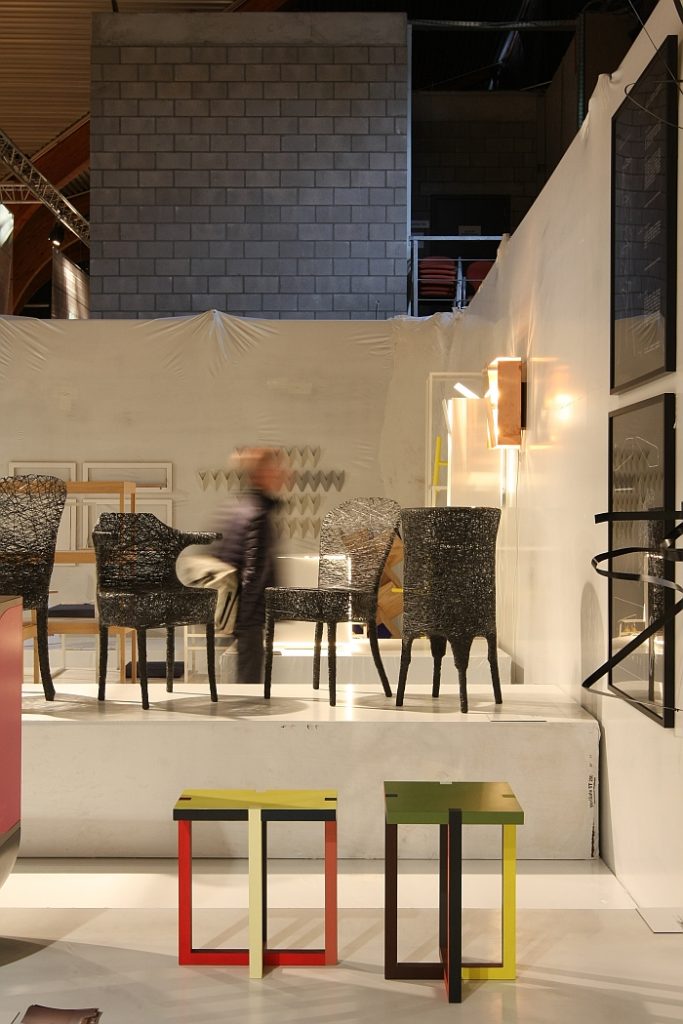With The Wall, Nieuwe German Gestaltung #004, the 2016 Biennale Interieur in Kortrijk presented an overview of contemporary German design.
All who know us will understand just how much it tickles us that one of the most ardent proponents of German contemporary design is a Belgian, Max Borka.
Not per se that Max is Belgian. But that Max isn’t German. That it takes a non-German to explain to Germans how good contemporary German design is. And that German design excellence needn’t always be about Dieter Rams, Ulm and gute Form. Can be. Needn’t be.
Back in 2009 Max Borka curated the exhibition Nullpunkt. Nieuwe German Gestaltung at Marta Herford, a largely experimental, conceptual based exhibition whose title and concept played on the idea of a reinvention of the dynamism of the post-modern New German Design movement, and which featured works by, and amongst many, many others, Konstantin Grcic, Werner Aisslinger, Mark Braun, Jerszy Seymour, Hermann Weizenegger and Osko & Deichmann.
In 2013 Max returned to the/his theme with the exhibition Refugium at DMY Berlin, if you will Nieuwe German Gestaltung #002, Nieuwe German Gestaltung #003 followed at State of Design Berlin 2016 and at Biennale Interieur Kortrijk 2016 Max Borka presented the latest incarnation: The Wall, Nieuwe German Gestaltung #004
Featuring works by 50 young(ish) German designers The Wall introduced, presented and extolled the virtues of the presented works largely according to a Forms Follows XXXXX strategy.
And thus neatly referenced Max’s Form Follows Foco project.
Except here it is:
Form Follows Folklore in the case of Designstudio Niruk’s StammTisch
Form Follows Fabrics in the case of Zascho Petkow’s fabric coated furniture
Form Follows Flow in the case of Anna Badur’s Blue Sunday tableware collection
To quote just three.
Three whom together with the other 47 provided a very diverse, very satisfying, and for all very realistic impression, of the contemporary German product design landscape and the range of very high quality, individual, occasionally idiosyncratic, work being realised by designers who are not afraid to follow their own vision and to develop their own ideas rather than look and see what a perceived market may need. And who thus are helping advance a contemporary understanding of design. But then given that the majority of the designers have featured in these pages, we’re probably damned to like it. Anything else being tantamount to an admission we were wrong.
Yes the list of design studios not represented would in itself suffice for a well-filled and extremely competent coffee table book on contemporary German design, but one can never show everything. But enough to whet appetites. Ours already was. Everybody else’s should be. And given the increasing number of interesting design brands in Belgium, perhaps the location wasn’t the daftest,
If there was one slightly negative aspect about The Wall it was that it was somewhat cramped into a wholly inadequately small 100 sqm meter space; however, in January Nieuwe German Gestaltung #005 will be staged as a much larger, certainly more spacious, possibly even more audacious event under the title Naked Objects during the Passagen Design Week in Cologne.
A showcase to be held in Cologne’s Belgian Quarter.
Which yes, tickles us…..
A few impressions from Kortrijk, and full details on all participants can be found at The Wall, Nieuwe German Gestaltung #004
